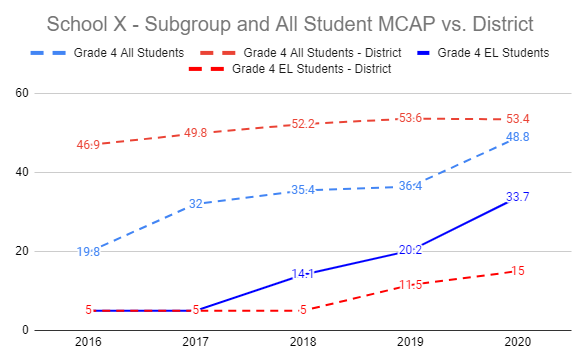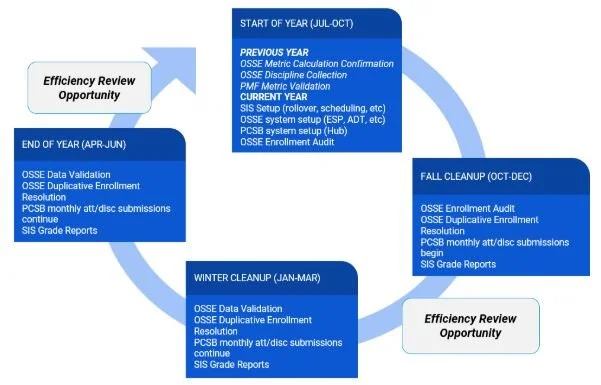It's budget season which means we are looking closely at costs for next year. If you are reeling from sticker shock after speaking to your vendor partners, take solace that you are not alone.
Our student data team partnered with the Maryland Alliance of Public Charter Schools to develop a series of webinars and accompanying tools aimed at supporting school leaders in identifying and effectively communicating their school’s success story using data.
In our work of conducting finance function assessments, we’ve found it’s often hard for school Boards and others who don’t work every day on school finance to accurately gauge the health of a school’s financials and finance office. To help with that conundrum, we have developed a quick EdOps School Financial Health Self Assessment that identifies the most important financial metrics and best practices.
Our Consulting Team recently helped a nonprofit education organization strengthen its finance function. While EdOps concentrates exclusively on supporting schools and therefore couldn’t take on this client for monthly finance support, we helped the organization find a financial services vendor that suited its needs.
If you are like many school leaders right now, you are both excited to access all the COVID stimulus available, but also a little anxious about how best to utilize this funding. You are hoping the funds will help you (1) maintain your program in the near-term with all of the demands of a pandemic environment while also (2) maintaining financial sustainability after the funds wind down. You are not alone and we are here to help you think about a plan for allocating these resources. This blog post will give an overview of the funding available and a step-by-step process for building COVID grant budgets.
Good financial reports are a school CFO’s most undervalued tool. When EdOps performs a school finance function assessment, we routinely find that the challenges we uncover are caused not by ineffective staff or bad software, but by an absence of clear, concise, understandable, and agreed-upon financial reports. Too often, the financials boards receive are simply a PDF printout of a year-to-date income statement from the school’s accounting system. While this meets the minimum bar of keeping the board apprised of the school’s financial position, good financial reports tell a story. They are tailored to their audience, and they explain not just the “what” but the “so what.” At the board level, good financial reports enable robust discussion of financial options, even from board members without a financial background; they provide an accurate picture of the financials prior to the annual audit; and they lead to faster, more strategic decision making.
As we prepare for an unusual start to the school year, we are striving to make staff feel like valued members of our communities. One element towards that is having routine operations running smoothly so that attention can be focused on the students and their learning experience. Payroll is a predictable element of running a school that, if done well, is hardly thought about by staff – except maybe on pay day! Payroll mistakes, however, can be upsetting, stressful, and take up a lot of administrative time and energy to rectify. This is the first in a series with tips on how to process an error-free payroll based on our extensive payroll experiences with schools. We hope these will be helpful in increasing the accuracy of your payroll.
As we prepare for an unusual start to the school year, we are striving to make staff feel like valued members of our communities. One element towards that is having routine operations running smoothly so that attention can be focused on the students and their learning experience. Payroll is a predictable element of running a school that, if done well, is hardly thought about by staff – except maybe on pay day! Payroll mistakes, however, can be upsetting, stressful, and take up a lot of administrative time and energy to rectify. This is the first in a series with tips on how to process an error-free payroll based on our extensive payroll experiences with schools. We hope these will be helpful in increasing the accuracy of your payroll.
As we prepare for an unusual start to the school year, we are striving to make staff feel like valued members of our communities. One element towards that is having routine operations running smoothly so that attention can be focused on the students and their learning experience. Payroll is a predictable element of running a school that, if done well, is hardly thought about by staff – except maybe on pay day! Payroll mistakes, however, can be upsetting, stressful, and take up a lot of administrative time and energy to rectify. This is the first in a series with tips on how to process an error-free payroll based on our extensive payroll experiences with schools. We hope these will be helpful in increasing the accuracy of your payroll.
As we prepare for an unusual start to the school year, we are striving to make staff feel like valued members of our communities. One element towards that is having routine operations running smoothly so that attention can be focused on the students and their learning experience. Payroll is a predictable element of running a school that, if done well, is hardly thought about by staff – except maybe on pay day! Payroll mistakes, however, can be upsetting, stressful, and take up a lot of administrative time and energy to rectify. This is the first in a series with tips on how to process an error-free payroll based on our extensive payroll experiences with schools. We hope these will be helpful in increasing the accuracy of your payroll.
As we prepare for an unusual start to the school year, we are striving to make staff feel like valued members of our communities. One element towards that is having routine operations running smoothly so that attention can be focused on the students and their learning experience. Payroll is a predictable element of running a school that, if done well, is hardly thought about by staff – except maybe on pay day! Payroll mistakes, however, can be upsetting, stressful, and take up a lot of administrative time and energy to rectify. This is the first in a series with tips on how to process an error-free payroll based on our extensive payroll experiences with schools. We hope these will be helpful in increasing the accuracy of your payroll.
Planning for how to address the COVID slide, or even a COVID slowdown, is challenging given the undefined path of the next few months, but one thing that is certain is that data will play a more critical role than ever in efficiently and effectively planning to make up for lost time and learning. The key questions many are looking to answer – which data to use, when to collect the data, and what to do with the data. While no consensus has been reached, a number of ideas and strategies are emerging that capture how schools plan to use current and future data to attack this learning slide.
On April 15, EdOps published “Budget Considerations from COVID-19,” detailing planning considerations that LEAs might apply to their contexts when budgeting for SY20-21. This post is a follow-up to share the planning efforts of specific LEAs on DC’s Deputy Mayor for Education’s Contingency Education Budget Planning Response Work Group. The intention of this post is to facilitate knowledge sharing among public charter school LEAs as they prepare their SY20-21 budgets.
A successful first day of school begins months before the first day of classes. Schools with strong data practices typically begin initial Student Information System (SIS) planning and preparation during the spring of the prior school year. A staff member or team coordinates the completion of major tasks so that the student information system is ready for use by the first day of school. We recommend this sample timeline to get you started and highlight four things that can derail these plans.
The Finance Committee leads the Board of Directors in performing its fiduciary duty to the nonprofit organization that runs the school. There are a number of key responsibilities that a Finance Committee must complete to support the school staff and the full board in their work.
This the second of our two-part series on best practices in board governance over academic performance. Part 1 focused on the responsibilities of an academic performance committee and the importance of creating a calendar around reviews of school performance. In this post, we delve further into how strong boards review school performance, as well as common metrics and visualizations that can help boards easily understand their student performance data. A board’s goal should look for ways to understand the trends in academic performance throughout the year, not just in a once-per-year snapshot when state assessment results are published.
Much is unknown about the impact or the duration of the COVID-19 crisis. In coordination with the D.C. Deputy Mayor for Education’s Contingency Education Budget Planning Response Work Group, EdOps led the development of potential revenue and expense implications the pandemic may have on local education agency (LEA) budgets. LEAs are encouraged to apply these considerations to their contexts.
As recommended by Education Board Partners in Standards for Effective Charter School Governance, the top priority of effective boards should be to ‘focus relentlessly on student achievement.’ Schools are in the business of providing top-notch education to students, and school boards should prioritize this principle in their work.
A personnel file audit is the periodic and systematic review of your personnel files to assess whether the documents in each employee’s personnel file are accurate, up to date, and complete. The audit helps ensure legal compliance, identifies HR process weaknesses and highlights HR successes.
A personnel file audit is the periodic and systematic review of your personnel files to assess whether the documents in each employee’s personnel file are accurate, up to date, and complete. The audit helps ensure legal compliance, identifies HR process weaknesses and highlights HR successes.
As a follow-up to last week’s post on strategies for improving attendance, this week we have a short post with suggested roles for everyone involved in the attendance management process. Defining roles is a key step in establishing your school-wide attendance plan.
The pathway to strong school attendance begins at the end of the previous school year and goes through September. Establishing an attendance plan during this time sets the foundation for the school year and is critical in forming positive habits toward meeting your annual attendance goals.
Blog Categories
Search
Throughout the year OSSE and PCSB ask schools to “validate” a number of student data points – from re-enrollment rates to PARCC achievement subgroup scores. Schools are asked to review and certify certain groups of data in OSSE’s or PCSB’s databases and confirm their accuracy (versus the school’s internal records). While data validation can feel daunting, making a roadmap at the beginning of the school year allows you to streamline validation task management during the school-year when there are so many competing priorities.
Schools are taking more assessments than ever before. While the output and data from assessments vary – RIT scores and percentiles from NWEA MAP or a percent score from Achievement Network – common challenges exist for school leaders, regardless of the exam. School leaders are all aiming to create meaning from student scores and put interim scores in context with end-of-year outcomes. This post identifies one method (of many) that will help leaders make sense of current assessment results and what they imply about end-of-year outcomes.
Data systems are great at making our schools run more efficiently… right up until a grade is missing on a report card or a student can’t log in on test day. As the web of interconnected systems grows in size and complexity, keeping your data clean and orderly is just as important as any software upgrade.
When thinking about financial compensation, most employees only consider salary. As an employer, however, you know that your financial contribution to staff is much greater than that. If you can better communicate the full value of staff compensation, you can improve both employee engagement and retention.
The benefits offered by your school can directly affect employee retention. In an earlier post, we covered flexibility benefit options, which account for four of the top valued benefits according to research from Harvard Business Review. Today, we are moving down the list to student loan assistance and tuition assistance.
Effectively analyzing school financial statements across multiple years can be challenging. Changes in facilities, organizational structure, fundraising strategies, or student population (including opening or closing campuses, adding new grade levels, or experiencing demographic shifts) complicate the comparability of financials.
Lenders want to know if you will pay them back. Whether you are considering traditional bank loans, taxable or tax-exempt bonds, or even special forms of financing created by state or federal government programs, the underlying question is the same. To find the answer, lenders look for assurances that your project and school will generate enough cash flow to service the debt (and that your school will stay open long enough to pay).
A well-conceived budget will serve as a “map” when making financial decisions throughout the year. It will reflect what you value as an organization, communicate your priorities to key stakeholders (board, staff, authorizer, families, funders), and highlight any new or changed priorities. Before the more technical work of the budgeting process begins, there are a number of broad concepts that we recommend every school focus on.
Assessment data comes in fast throughout the year and provides multiple opportunities for all stakeholders to learn about the performance of a school. With so many ways to slice the data, it can be difficult to identify the most important stories.
We have conducted several compensation studies helping schools develop a compensation philosophy and strategy that is best for staff and financially sustainable. Compensation, after all, is the most important factor candidates consider when evaluating multiple offers. However, we always push school leadership to remember that salary is just one factor and should be considered alongside many others.
We often begin our school budget training for charter applicants by asking the group to identify the major levers that impact total teacher salary expenses. Almost without fail, the two answers given are 1) teacher salary levels and 2) average class size. What most people overlook is that there is a third, equally important lever: 3) schedule configuration.
The Student Information System (SIS) serves as a school’s database of enrolled students, their attendance, class schedules, parents and emergency contacts, and often much, much more. The SIS is like a school’s brain – critical to its ongoing functioning – and so adopting or switching to a new one is no small decision. Although needs vary between schools, some basic considerations apply across the board. This post aims to familiarize you with some of the main questions to ask yourself (and prospective vendors) before making a decision
As many school administrators and staff already know, approximately 90% of funding received by schools is driven by enrollment. Student recruitment can drive enrollment, and thus has a significant impact on the financial stability of your school.
Operating with a low supply of cash reserves can be an extremely stressful situation for any business. This can be a particularly daunting challenge for public charter and independent schools as cash inflows do not always align well with required cash outflows.
Attracting and retaining high-quality employees is critical to school success. One of the ways school leadership can show its staff, both new and returning, that they are valued is by offering benefits that they truly value.
Building on our data experience with schools, we have compiled best practices for managing the communication and wider dissemination of state test results across critical internal stakeholders.
Attendance and absenteeism are continuous educational challenges. However, before schools can effectively address absenteeism and improve their attendance rate, it is critical to understand common factors that can impact the students they serve.
As more and more data is made available to educators, data dashboards are increasingly hailed as one-stop, silver bullet solutions to school problems. Despite investing money and staff time into data visualization software and dashboard development, end-users (principals, instructional coaches, and teachers) often don’t find the information useful. We believe that dashboards are not a solution on their own. It’s the analysis and communication of the data that makes it useful to educators and directs their time, passion and attention.
All too often school leaders go through the process of making a budget – only to let it collect dust once it’s complete. A budget done well transforms abstract goals into concrete numbers and allows you to track progress towards those goals throughout the year. If you are not coming back to your budget on a regular basis as the year progresses, you can stray from your goals and expose your school to unintended risks.
We have found in our work around the country that schools struggle to implement their succession plans even after they are created. Too often a succession plan sits untouched until a leadership transition occurs, and the organization stumbles because team members have not been trained on the challenges of roles outside of their own.
Every year, our schools ask us questions like, “How are other schools spending their student recruitment dollars?,” and “How much are other schools spending on student transportation?” While school leaders know what they have spent in the past and plan to spend in the future, they often don’t have helpful information about their peers. Additional student expense categories are covered in this post.
We all know how complicated it can be to run a single school, but growing organizations face even greater complexity. Through our work with expanding schools, we’ve found some useful questions to keep in mind when determining which roles and responsibilities should remain at individual schools and which should be centralized.
Accurate enrollment records are critical not only for building a clear picture of school demographics and student mobility, but also for ensuring receipt of appropriate funding. Consistently using entry and exit codes are key aspects of maintaining accurate student enrollment records.
Revenue from annual student enrollment typically makes up 75% to 95% of a school’s budget, so hitting enrollment targets each year is critical. To ensure all parties are able to make key decisions and help the school stay on track, it is important to maintain an open and clear line of communication between Executive, Finance, Student Data, and Operational personnel.
From our conversations with school leaders, we know that state report cards can be challenging to tackle, especially as the school year comes to a close. We wanted to better understand how report card scores fluctuate over time, so we did some digging into trends over the last few years using the District of Columbia’s Performance Management Framework (PMF) as an example.
Every year, our schools ask us questions like, “How are other schools spending their student recruitment dollars?,” and “How much are other schools spending on student transportation?” While school leaders know what they have spent in the past and plan to spend in the future, they often don’t have helpful information about their peers. Additional student expense categories are covered in this post.
Every year, our schools ask us questions like, “How are other schools spending their student recruitment dollars?,” and “How much are other schools spending on student transportation?” While school leaders know what they have spent in the past and plan to spend in the future, they often don’t have helpful information about their peers.
School leaders often ask us about benchmarking for key spending categories – how does our spending on (curriculum) / (food service) / (security services) / etc. compare to other schools? Our breadth of school partnerships allows us to see how similar schools are allocating their dollars, and how much they are spending overall.
Many smaller charter schools maintain a single budget managed by the Executive Director and COO; however, as schools grow, Executive Directors often choose to empower a larger group of staff members with insight – and input – into their spending plans and activities.
Teachers and administrators need access to high-quality student data to make instructional and intervention decisions. However, getting access to this data can be a challenge in the face of staff turnover, the large number of data systems, the high volume of external data requests, and the lack of coordination among different teams.













































